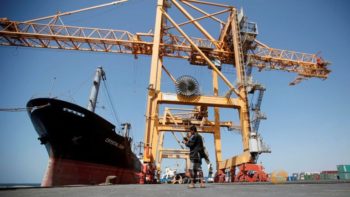
Cruise missiles, floating mines and a remote-controlled boat have been deployed to attack ships in Yemen in recent months, changing the dynamic of the two-year-old war and pushing the country closer to famine, shipping and aid officials say.
The weapons have targeted military vessels from a Saudi-led coalition which is fighting Iranian-allied Houthi rebels in the impoverished state on the tip of the Arabian peninsula, part of the same regional power struggle that is fueling Syria’s war.
The conflict in Yemen, which al Qaeda has exploited to thrive amid turbulent conditions, has left four-fifths of the population in need of aid. Relief officials say food reserves will run out in two to four months.
Increasingly innovative maritime raids near the narrow Bab al-Mandab maritime passage, which connects the Red Sea with the Gulf of Aden and the Arabian Sea, add to already severe difficulties getting aid and commercial supplies to a country that imports 90 percent of its food and fuel by sea.
Saudi-led air strikes close to vital ports in the Houthi-controlled north are also curbing imports, shipping sources say. Both sides deny hampering aid.
“The potential for merchant ships to be caught up in this as collateral damage is high,” said Phillip Belcher, marine director with INTERTANKO, an association which represents the majority of the world’s tanker fleet.
“Several of the attacks on military operated vessels have taken place in close proximity to merchant ships,” he said.
With nearly 4 million barrels of oil shipped daily to Europe, the United states and Asia plus commercial goods via the waterway, the stakes are high for ships sailing through the strait and for those making stops at ports in Yemen.
A Saudi frigate was attacked on Jan. 30 close to the Red Sea port of Hodeidah in which two crew members were killed and three wounded, Saudi official media reported, blaming Houthis for the attack.
The U.S. Navy said an unmanned remote controlled boat laden with explosives rammed the Saudi navy vessel, the first known strike by a “drone” attack boat, adding it was likely the Houthis were responsible, using technology supplied by Iran.
Iran rejects accusations made by Saudi Arabia and its regional allies that it gives financial and military support to Houthis in Yemen, blaming the deepening crisis on Riyadh.
“Riyadh and its allies are responsible for the bloodshed in Yemen,” a senior Iranian official told Reuters.
“All those claims about Iran’s involvement are baseless and fabricated news.”
There was no immediate comment from the Houthis or from Iran’s Revolutionary Guards, which operates hundreds of small military craft.
James Burnell-Nugent, former commander in chief of Britain’s Royal Navy, said the use of an unmanned vessel introduced a new complication to maritime security in the region.
“Both the Bab and Hormuz are criss-crossed by lots of small vessels, often traveling at speed. Most of them are non-hostile, carrying contraband such as cigarettes. Amid this constant traffic, it is already very difficult for navies to pick out who is hostile and who isn’t,” he told Reuters.
Al Qaeda may also have carried out its first attack off Yemen’s shores in more than a decade, security specialists say.
On Oct. 25 unknown assailants opened fire on the Galicia Spirit gas tanker close to the Bab al-Mandab. The vessel’s owner said the attackers were also carrying a substantial amount of explosives.
There has been no claim of responsibility for the attack.
Gerry Northwood, of maritime security firm MAST and a former British Royal Navy captain with experience commanding warships in the region, said he suspected the attack showed al Qaeda’s ability to carry out seaborne strikes on tankers.
Other incidents have included an attack on Oct. 1 on a United Arab Emirates craft with what some Western experts say appears to have been an anti-ship cruise missile. The Houthis said they attacked the ship but have made no comment on the weapons used.
The Houthis denied they were behind a series of failed missile attacks in October on the U.S. navy destroyer USS Mason, actions which drew retaliation in the form of U.S. cruise missile strikes on coastal radar sites in Houthi-controlled territory.
Shipping industry sources say shipping firms were becoming more reluctant to deliver goods to Houthi-controlled Hodeidah port together with the neighboring port of Salif also on the Rea Sea.
Robert Mardini, regional director for the Near and Middle East with the International Committee of the Red Cross (ICRC), said it had stopped using Hodeidah, which is one of the major gateways for goods into Yemen.
“Nobody wants to go to Hodeidah … from our list of suppliers. So this is problematic,” he said this week. The ICRC added it had not used the port for several weeks.
The reluctance compounds delays in aid deliveries that have been reported at Hodeidah for months. The United Nations has said both sides have been holding up aid deliveries.
The coalition denies blocking food or hitting infrastructure and says the Houthis routinely hold up aid deliveries and divert resources to the war effort, charges the Houthis deny.
Further down the coast, al-Mokha city became the focus of alarm after the U.S. government’s Maritime Administration said in late January it had reason to be believe Houthi fighters had laid mines close to the mouth of the harbor. The Houthis have not commented on the allegation.
A maritime source familiar with the area said that, depending on the current, any free floating mines could be pushed into the open sea in an area close to the Bab al-Mandab.
More than 10,000 people have been killed in the conflict, which the United Nations has said is now the largest food insecurity emergency in the world, with an estimated 7.3 million people needing immediate help.
Copyright Ships & Ports Ltd. Permission to use quotations from this article is granted subject to appropriate credit given to www.shipsandports.com.ng as the source.
